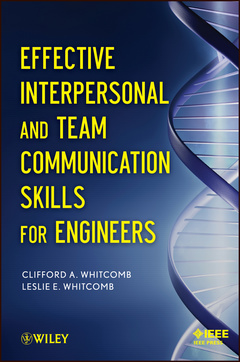Effective Interpersonal and Team Communication Skills for Engineers
Langue : Anglais
Auteur : WHITCOMB Clifford

Historically, the need for communication skills was not particularly emphasized in engineering education. However, recent studies show that clear, spoken communication is an essential competency for an engineer. This book introduces key principles of communication that support clear exchanges in a technical context. Using self–assessment tools and practical examples, as well as engineering–specific case studies, the book helps engineers develop effective communication and presentation skills, allowing them to successfully respond to technical challenges in day–to–day engineering jobs.
PREFACE xiii ACKNOWLEDGMENTS xxi SECTION I LEARNING THE BASICS 1 1 LEARNING TO DRIVE YOUR COMMUNICATIONS 3 Communication Microskills Model 4 Why are Microskills Important as a Basis for Communication in Engineering? 4 How Do MicroskillsWork? 6 How will I Learn the Microskills? 7 What’s in it for Me? 7 Why this Works 7 The Importance of a Practice–Based Model 8 2 WHAT DOES IT MEAN TO BE AN EFFECTIVE ENGINEERING COMMUNICATOR? 11 Shared Basis of Engineering Communication Exchanges Defined 13 Space, Face, and Place Spectrum Defined 15 Contextual Integration of Shared Communication Spaces 15 Check In 16 3 YOUR NATURAL STYLE OF COMMUNICATION 17 What are the Strengths of Your Natural Style? 17 Natural Style of Communication Defined 18 Contextual Integration of Your Natural Style 20 4 HOW SELF–UNDERSTANDING LEADS TO DEVELOPMENT OF EMOTIONAL INTELLIGENCE 23 Self–Understanding Microskills Defined 25 Self–Awareness 25 Self–Regulation 25 Self–Motivation 25 Empathy 26 Social Attention and Focus 26 Contextual Integration of Self–Understanding 26 5 DEVELOPING EMOTIONAL INTELLIGENCE 29 Emotional Intelligence Defined 31 Check In 33 Contextual Integration of Emotional Intelligence 34 6 AFFECT CHANGES YOUR COMMUNICATION 35 Affect Defined 38 Affect Defined in Everyday Language 39 Check In 39 Contextual Integration of Affect 40 7 AFFECT PROCESSING: THE HIDDEN KEY TO CLEAR COMMUNICATION 41 Internal Affect Processing Defined 42 External Affect Processing Defined 42 Balanced Affect Processing Defined 43 Affect Processing in Overdriven, Disconnected, and Clear Ranges 44 Overdriven Affect Response 44 Overdriven Affect Processing Defined 44 Overdriven Affect Processing Analogy 44 Overdriven Affect Processing Impacts on Engineering Communication 45 Disconnected Affect Response 45 Disconnected Affect Response Defined 46 Disconnected Affect Processing Analogy 46 Disconnected Affect Processing Impacts on Engineering Communications 46 Clear Affective Response 47 Clear Affective Response Defined 47 Clear Affective Response Analogy 47 Clear Affective Response Impacts on Engineering Communication 48 Contextual Integration of Affect Processing 49 SECTION II TAKING IT TO WORK 51 8 I, YOU, AND THE TEAM 53 “I” Statements Defined 54 Check In 55 Contextual Integration of “I” Statements 55 Opaque “I” Statements: An Example 56 Opaque “I” Statements Defined 56 Contextual Integration of Opaque “I” Statements 56 Misplaced “You” Statements: Examples 57 Misplaced “You” Statements Defined 57 Contextual Integration of Misplaced “you” Statements 57 Misplaced Team Statements 58 Misplaced “Team” Statements Defined 58 Contextual Integration of Misplaced “Team” Statements 58 You and We Complete the Exchange 59 Appropriate “You” Statements Defined 59 Good Communication: “We” Statements—Examples 60 Appropriate “We” Statements Defined 60 Check In 61 9 PAYING ATTENTION WITH ATTENDING BEHAVIORS 63 Verbal Communication Defined 65 Nonverbal Communication Defined 66 Nonverbal Attending Behavior for the Speaker: Soler 67 Nonverbal Attending Behavior for the Listener: Recap 68 Check In 69 Contextual Integration of Attending Behaviors 71 Check In 72 10 SHAPE YOUR COMMUNICATIONS USING OPEN AND CLOSED QUESTIONS 73 Open and Closed Questions Defined 74 Check In 75 Contextual Integration of Open and Closed Questions 76 Check In 77 11 MOVE INTO MULTIPLE DIMENSIONS WITH MULTIMODAL ATTENDING 79 Multimodal Attending Defined 81 Sensory Processing Defined 82 Affective Processing Defined 82 Cognitive Processing Defined 82 Check In 83 Contextual Integration of Multimodal Attending 84 SECTION III MAKING IT REAL 87 12 DEVELOP FLUENCY WITH ENCOURAGING, PARAPHRASING, AND SUMMARIZING 89 Encouraging Defined 90 Paraphrasing Defined 90 Summarizing Defined 91 Encouragers to Use 93 Nonverbal 93 Verbal 93 Paraphrasing Skills to Use 93 Summarizing Skills to Use 93 Adding Affect to Encouragers, Paraphrasing, and Summarizing 94 13 CLOSE THE LOOP WITH REFLECTION OF FEELING 97 Reflection of Feeling in the Dialog between Lisa and Nestor 98 What Happens when Feelings are not Reflected 98 Tracking Reflection of Feeling 99 Benefits of Tracking Reflection of Feeling 99 Feedback Loops that Balance Feeling and Thinking: Accurate Reflection of Feeling 100 14 THE SIX–STEP CYCLE 105 Six–Step Cycle for Interpersonal and Technical Communications 107 Engineering Project Scenario Revisited 109 Step One: Identify Context 109 Step Two: Define the Problem 109 Step Three: Define the Goals 109 Step Four: Generate Alternates 110 Step Five: Take Action 111 Step Six: Iterate 111 Check In 112 SECTION IV TAKING THE LEAD 113 15 WORKING WITH CONFRONTATION AND CONFLICT NEGOTIATION 115 Confrontation 115 How to Clear Obstacles Using Conflict Negotiation 121 Conflict Negotiation Rules 124 16 BECOMING AN INTENTIONAL ENGINEER 135 BIBLIOGRAPHY 139 INDEX 141
Date de parution : 03-2013
Disponible chez l'éditeur (délai d'approvisionnement : 12 jours).
Prix indicatif 56,35 €
Ajouter au panier
© 2024 LAVOISIER S.A.S.



